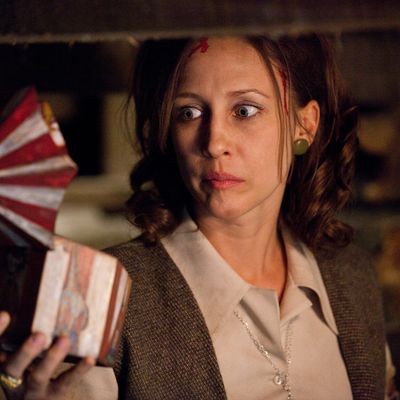
In James Wan’s The Conjuring, the camera doesn’t just follow, it stalks. It peers, pursues, intrudes, and it never seems to let up. It starts to follow a young girl and her mother through their new house, then cuts to an ominous zoom toward another sister, then cuts to a shot that cranes up to reveal the house from outside. The family and their house — the “victims” — seem to be always in the center of the frame. Like the demons that will soon pursue these characters, the camera doesn’t let go. More so than the actual scares — and there are plenty of those, too — The Conjuring succeeds because of all that anticipation of dread things to come. The damned thing works you so well that you may even consider leaving halfway through, for fear you’ll have a heart attack.
The film opens with the introduction of the famous husband-and-wife team of paranormal investigators, Ed and Lorraine Warren, played by Patrick Wilson and Vera Farmiga. The real-life Warrens were the ones who first investigated the Amityville hauntings, and The Conjuring purports to be based on a previously undisclosed case; one assumes that if this film becomes a franchise, the Warrens will become the James Bonds of horror. We even meet them in Bond-like fashion, in a pre-credits scene that shows them on an earlier case, helping a trio of kids come to terms with a possessed doll. This brief early section also clarifies an important point: The Warrens aren’t mythbusters, but believers. Ed’s a devout Catholic, and Lorraine is clairvoyant. They also have a matter-of-fact way of dealing with such nasty concepts as demonic possession and evil inanimate objects come to life. (There’s even a whole room in their house where they store the remnants of their investigations.) These investigators exude confidence and calm — so that when they start to look worried, you know something’s up.
Cut to: The Perron family, moving into their nice, big rural house, happy to have finally escaped the big city. Dad Roger (Ron Livingston) is a blue-collar type, while mom Carolyn (Lili Taylor) is attentive, loving, playful, which she needs to be to deal with her five daughters. Before you know it, though, doors are creaking open, birds are showing up dead, and things are going brrooommph in the night. Perhaps even more worryingly, mom’s starting to show bruises and the kids are making new imaginary friends. Soon enough, the Warrens and their team are moving in, Poltergeist-style, and setting up special cameras and recording devices and other thingamabobs.
There isn’t anything particularly new or original that The Conjuring does; this is about as old school as old-school horror gets. (The movie even takes place in the early seventies.) But Wan, who gave us the first Saw and Insidious, has been trafficking in old-school horror motifs for a while: ventriloquists’ dummies, possessed dolls, dark cellars, children’s drawings of red faced demons … he knows a good, workable horror cliché when he sees it. And he’s been developing into a better director, too, finding ways to channel his perverse, Lynchian sensibilities and love of baroque camera movements in ways that serve the story rather than smother it. (Saw got goofy whenever it got stylish; The Conjuring works so well in part because it’s so stylish.)
It all seems relatively simple, but Wan walks a deceptively fine line. The film is constantly in motion, yet somehow still patient, rarely frantic. It’s brutal and relentless — people get possessed, people get knocked around, people get exorcised — but never sadistic. For all the obligatory crossings and calls to the Vatican and religious iconography throughout, the film’s climax turns on an emotional flashback — a happy one, go figure — and you never feel like you’ve been manipulated or sold a bill of goods. The Conjuring makes screams the old-fashioned way: It earns them.


